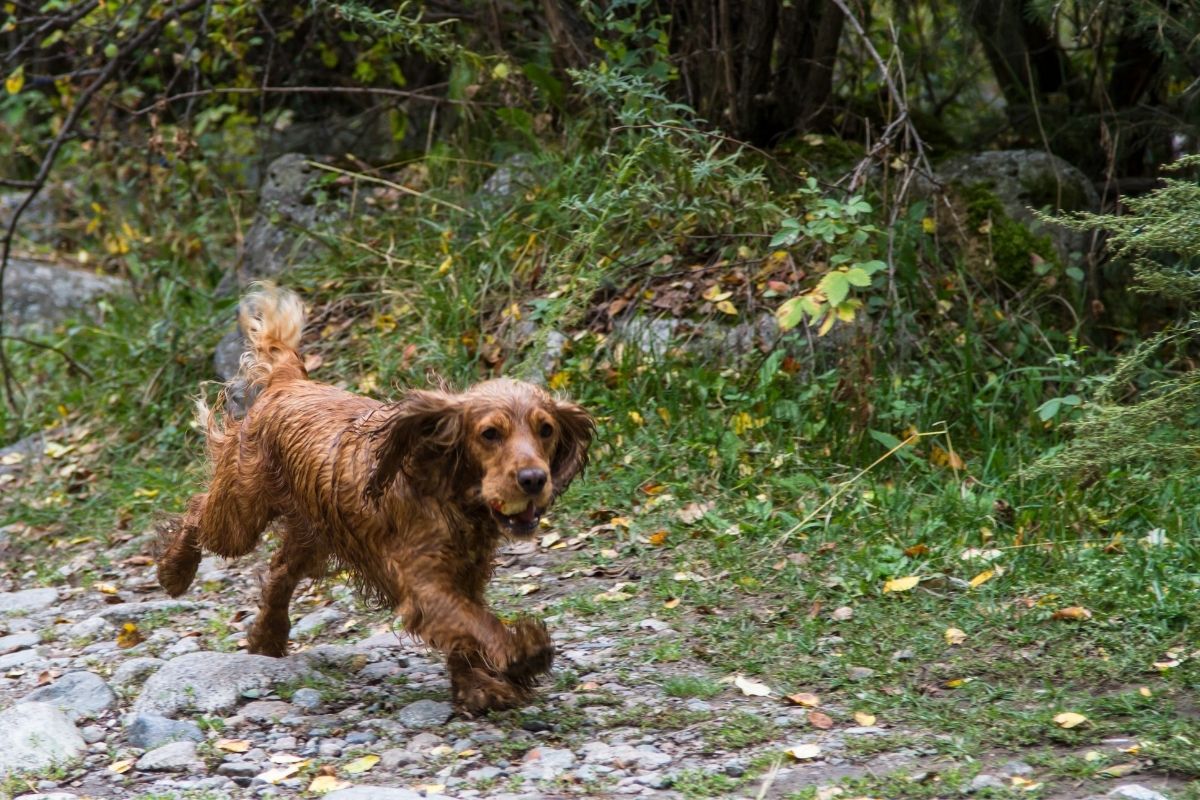One of the most difficult things for many novice spaniel trainers is that of allowing your spaniel to hunt his ground properly.
Often you’ll see dogs being handled excessively, mainly due to the nerves of the handler and this can result in lost marks in formal spaniel competitions.
It can also lead to lost and unfound game when out and about working on the shoot.
A working Cocker spaniel should be able to hit cover and throw it over his back, getting into and beneath the cover, as this is where game such as pheasants and rabbits, will be taking cover. Your dog needs to become a cover attacker, where nothing is too tough for him.
Get your spaniel into the cover
It’s really important that you encourage your spaniel to get into the cover and to enjoy doing so.
This is his job and it is where he is going to find the most scent and the most game – which is what we want and need him to do.
I’ve seen many spaniels jumping around like deer when they meet cover ( which is why in some circles this is known as ‘stagging’ ) and even worse, I’ve seen these dogs in the awards at field trials.
If you allow your spaniel to ‘hunt‘ in this manner then you are going to miss game – which in a competition is a disqualification ( if you are found out ) and, on a shooting day results in a lower bag.
Be wise about your choice of cover when training
Eventually you will want your spaniel to hit all manner of cover without so much as a second thought but you need to be measured when training a young spaniel in terms of the type of cover that you’ll use.
I’ve always found that dead bracken is an ideal option for dogs of all ages as it has a tendency to fold rather than sink solidly to the ground.
Most patches of bracken are light enough for a spaniel to get into easily.

How to get your spaniel into the cover
In most cases, with a working bred dog, you’re not going to have a great deal of difficulty with this aspect of training.
Most working Cocker spaniels will happily explore cover such as bracken and when they discover the myriads of scent that lie underneath they soon enjoy the activity.
If your dog does show some reluctance then working on a reward type basis will often deal with this.
Try rolling a tennis ball, in full view of your spaniel, into the cover and then send him in to fetch it.
Once he becomes confident then roll the ball in in a manner that means he has to hunt for it while in the cover, he’ll spend more time inside, will cover more ground as he works out the retrieve and will be rewarded for his efforts when he finds the ball.
If your spaniel doesn’t care much for a ball then try a canvas or fur dummy.
The idea is to help your spaniel associate the cover with a reward and with doing something that is fun – hunting for a ball of dummy and then finding it forms the basis of the fun and makes his effort worthwhile.
Keep it varied too
As your Cocker learns to enjoy getting into cover when he is hunting try to vary the terrain and cover that your encounter.
In most areas this should not be too difficult to do as cover does tend to vary as you move around.
You should give your spaniel as much experience of different types of cover as is practically possible and should introduce him to things such as:
Bracken – this is great fun and allows the dog to explore and get underneath easily.
Rushes – often found on areas of moorland, rushes are great at holding scent and, as they often grow in clumps, they are excellent for helping your spaniel learn how to cover ground – by moving from clump to clump and exploring you teach your spaniel to look at every game holding opportunity.
Woodland – woods and forests present lots of cover, from fallen trees and branches, patches of long grass and bracken and a wide range of other areas that are ideal for a spaniel to get into and underneath.
Hedges and hedgerows – exploring these along the sides of fields can be great fun for a dog – keep an eye on him though as spaniels have a tendency to run on ahead as they explore these types of cover.
If he starts to pull ahead, whistle him back, sit him down, and, when he has calmed down, send him off again. Always try to keep him close to you.
[amazon box=”1853104191″ template=”horizontal”]
Keep your spaniel close in cover
But don’t over handle him. You should allow your dog to work the cover but try not to let him pull or get too far from you.
Don’t worry about pattern or quartering – you want your dog to get in and cover the ground.
If he misses a patch then whistle him in and direct him to explore the cover – always aim to cover all of the ground ahead of him – taking into account the wind direction and scenting conditions.
If you have to then get into the cover with him .It’s one of the joys of spaniel training and handling and you will get wet and dirty.
Be patient, keep it interesting, don’t stress
Your spaniel has to be good at hunting in cover and, if he is a working bred Cocker, then it’s unlikely that you’ll have any problems.
Give your dog exposure to different types of cover but don’t overdo the tough stuff when he is a youngster.
Make it interesting and combine the sessions with some retrieving and some other activities that the dog enjoys.
Final Words
Hunting with your Cocker should be good fun. It’s the most enjoyable activity for me as a handler and for the dogs too.
Treat your hunting training as an adventure with your dog, explore different types of cover and introduce some retrieves as your go along.
Don’t overdo it when the weather is warm and, if you have more than one dog then make them take turns when hunting – keeping the other on the lead.
When you’re more confident you can work them both together – which is really good fun.




